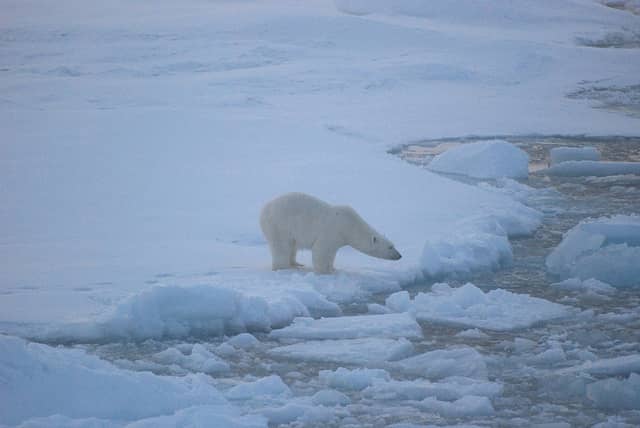Polar Bears’ Threatened Status Challenged in U.S. Appeals Court
OutdoorHub Reporters 10.24.12

In a string of ongoing lawsuits, Safari Club International (SCI), the state of Alaska, the California Cattlemen’s Association and other parties are appealing a decision by the U.S. District Court that upheld the status of the polar bear as a threatened species. A separate lawsuit challenges the ban on the importation of legally hunted polar bear parts into the United States from Canada that arose with the listing.
In May of 2008, the polar bear was listed as a threatened species under the U.S. Endangered Species Act “because of ongoing and potential loss of their sea-ice habitat resulting from climate change,” according to U.S. Fish and Wildlife Service (FWS) documents. It is also a federally protected species under the Marine Mammal Protection Act of 1972. Since the polar bear spends many months of a year on sea ice, it is considered a marine mammal.
SCI got involved in the case when the 2008 listing restricted “imports of polar bear trophies that were hunted from approved populations in Canada,” according to Doug Burdin, SCI’s lead attorney on polar bears. Before the listing, U.S. hunters were allowed to import polar bears legally hunted from five approved populations in Canada into the United States. This was authorized by a 1996 amendment to the Marine Mammal Protection Act.
In order to import any trophy, each hunter had to pay a $1,000 import fee, the proceeds of which went toward funding polar bear research in Alaska and Russia. From 1996 to 2008, there were 950 to 1,000 permits issued to import polar bears. This raised close to $1 million for research over those 12 years.
While the bears are considered threatened in the U.S, it is still legal to hunt them in Canada. There is a quota of bears assigned to native communities, primarily for subsistence purposes, set by the various Canadian governments for the bear populations. The communities assign a certain number of bears from the quota, usually no more than 15%, to foreign hunters, who until recently were mostly U.S. hunters. “There are U.S. hunters who desire to go to Canada to hunt the polar bear,” Burdin said. “For a lot of the hunters, it wasn’t worth the high cost, ranging from anywhere around $40,000 to $50,000, if they are not able to bring their trophy back to the United States.”
The quota of bears allowed to be hunted is set by the Canadian governments and made known to locals. “Once the quota is set and provided to the native communities, whatever the quota is, they are going to take that number of bears and sell some of the hunts to U.S. or [other] foreign hunters,” Burdin said. “The fact that U.S. hunters can import into the United States does not affect the annual mortality of polar bears. Some people are concerned, and falsely claim, that hunters increase polar bear mortality, but the fact is the quota numbers will be taken regardless of whether there are U.S. or foreign sport hunters.”
Currently there are estimated to be 20,000 to 25,000 polar bears worldwide, which still inhabit their entire historical range. Of those polar bears, 3,500 reside in Alaska. The reason Fish and Wildlife Service believes the polar bear is threatened is because various models indicate that the sea ice of its arctic habitat will decrease such that the bear will be adversely affected within the next 45 years. Arctic sea ice has suffered some declines, especially summer ice levels. This year’s summer sea ice currently sits at a record low of 1.32 million square miles as of mid-September.
Oral arguments for the case were heard Friday, October 19. Murray Feldman, a lawyer for the state of Alaska, said that is not enough basis to list the polar bear as threatened. Feldman asserted that the Fish and Wildlife Service’s decision to list the animal is “arbitrary and capricious” and “based on flawed models.”
At the same hearing, Katherine Hazard, a lawyer with the FWS, said the agency’s decision to list the polar bear was based on “decades of research and long-term trends that underpinned it.” Bruce Woods, a spokesman for FWS, said the listing triggered funding for programs to help conserve the polar bear, which included patrols to limit polar bear-human contact.
Burdin said there are a number of lawsuits pending against the listing. Although each organization has its own reasons for appealing the decision, the lawsuits are being considered as one case (Safari Club International et al v. Ken Salazar et al and Center for Biological Diversity et al, Circuit case No. 11-5219). The state of Alaska is involved because it seeks state management of the animals and their habitat. The listing led to the designation of critical habitat, which could also limit how the state and industries use the land, including oil and gas development.
It is likely to be several months before a decision is reached by the court.

